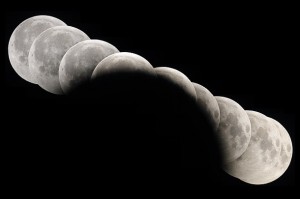Tomorrow (Saturday December 10) the Moon will pass into the Earth’s shadow, causing it to plunge into ruddy darkness, an event called a total lunar eclipse. These happen roughly twice a year somewhere on Earth, but this is the last one visible in North America for more than two years, so even though it’s in the morning it might be worth a look for you.
 You can get all the info you need on watching the eclipse from my pal Alan Boyle over at the Cosmic Log, including timing, locations, and where to watch live online, too. NASA has a page with more detailed information as well. This one favors US folks farther west; the Moon will have set when the eclipse really starts for East Coast folks.
You can get all the info you need on watching the eclipse from my pal Alan Boyle over at the Cosmic Log, including timing, locations, and where to watch live online, too. NASA has a page with more detailed information as well. This one favors US folks farther west; the Moon will have set when the eclipse really starts for East Coast folks.
But the fun begins when the Moon starts to enter the deepest part of the Earth’s shadow at 12:45 UT (04:45 Pacific US time), and the last bit passes into shadow at 14:06 UT (06:06 Pacific). Deepest eclipse is about 25 minutes after that. Interestingly, for people in the western US, that’s around the same time as sunrise. For me, the Sun rises at 07:12 (Mountain time) Saturday, and the Moon sets at 07:14 – when it’s still partially eclipsed! Unfortunately, the mountains to the west will block my view of the setting Moon.
But for those of you with a clear horizon to the east and west, you may get an extraordinary opportunity to very briefly see the Sun and eclipsed Moon at the same time! Normally this isn’t possible; by definition the Moon and Sun have to be directly opposite each in the sky to get an eclipse at all.
But due to a quirk of geometry and atmospheric physics, it is possible. The Earth’s air acts like a lens, bending the light from objects near the horizon. Because of this effect – I give a full explanation here – you can actually see the Moon for a minute or two after it has physically set; its light is bent “around the corner”, so to speak, so both it and the Sun will be over the horizon for a short amount of time. You can face west to see the setting eclipsed Moon, then turn around and see the rising Sun in the East!
Pretty cool. To see if you get a chance to experience this, check the time the Moon sets for you, the time the Sun rises, and compare them with the eclipse times from the NASA site (don’t forget to correct for time zone differences; Pacific time is UT - 8 hours).
NASA put up a nice video on YouTube describing all this. However, they make one mistake in it near and dear to me. Can you guess what it is?
Yup. They talk about the Moon Illusion – the Moon looking bigger on the horizon than overhead, saying,
Not only will the Moon be beautifully red, it will also be inflated by the Moon Illusion. For reasons not fully understood by astronomers or psychologists, low-hanging Moons look unnaturally large when they beam through trees, buildings, and other foreground objects. In fact, a low Moon is no wider than any other Moon – cameras prove it – but the human brain insists otherwise. To observers in the western United States the eclipse will appear super-sized.
ARRRGGG! That’s not correct. First, we do have a pretty good understanding of it! I have a detailed explanation of what causes the Moon Illusion, and it’s a combination of two well-known illusions: one of which is how we perceive the size of an object depending on its distance, and the other which makes us think the Moon is farther away on the horizon than when it’s overhead. Second, while the foreground object explanation is a very common one, at best it’s incomplete, and I think it’s not really relevant – the illusion still occurs when you have a flat horizon with no foreground objects (I’ve seen it in Kansas and Oklahoma while standing on farmland with nothing between me and the Moon but our own thin skin of air).
If you prefer explanations in cartoon form, then try this one at Sci-ence. I promise not to pop out of the bushes at you.
Anyway, when you put all this together, due to an atmospheric trick you have a chance to see the Sun and eclipsed Moon at the same time, and due to a brain trick they may both look huge as they squat on the horizon. If you’re in one of the locations where this is possible, go take a look! And if you get good pictures, link to them in the comments below, send a link to me via email (no attachments, please), and/or send them to Universe Today, which is always looking for good astrophotos.
Image credit: Anthony Ayiomamitis, who has a fantastic collection of eclipse pictures he’s taken over the years.
Related posts:
- Why does the Moon look so huge on the horizon?
- Didja see the eclipse?
- My new favorite lunar eclipse image
- In the shadow of the Earth
- Incredible lunar eclipse floats near the Lagoon
- Time lapsed: the Moon plunges into shadow
- STUNNING lunar eclipse photo